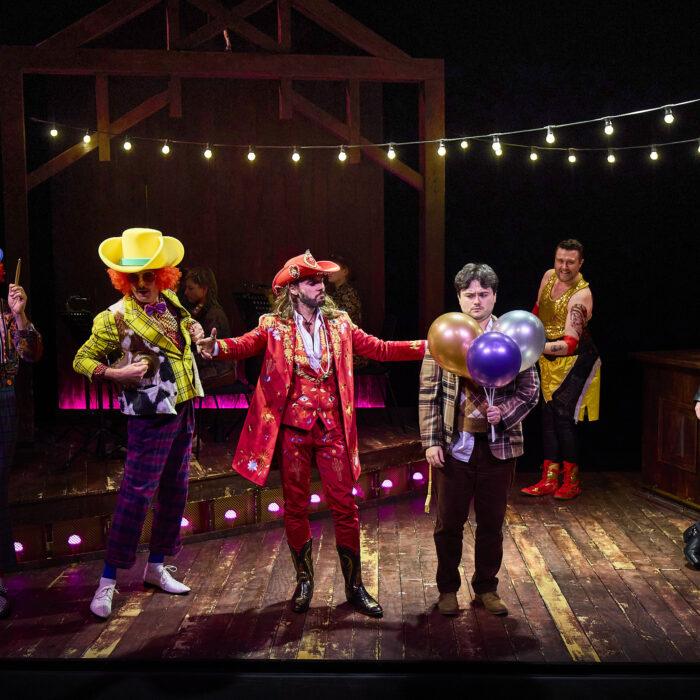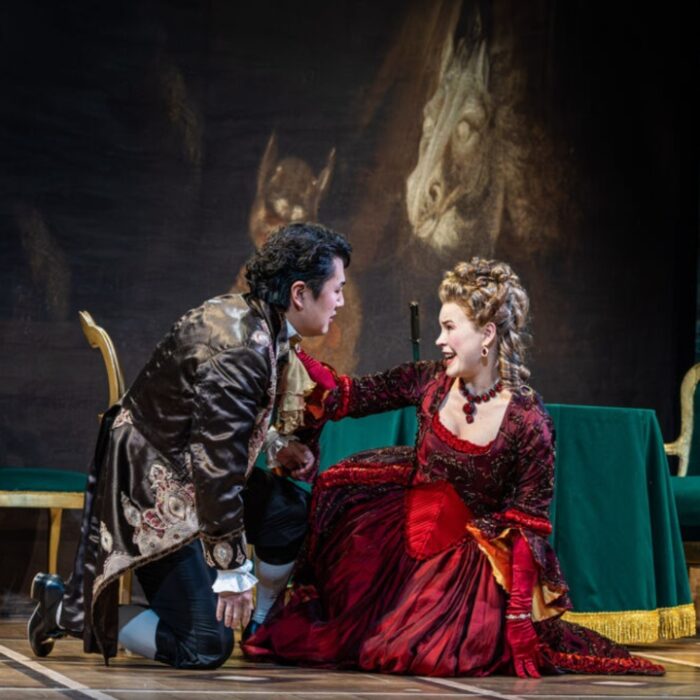
San Francisco Opera 2019-20 Review: Le Nozze di Figaro
Jeanin De Bique, Serena Malfi, Nicole Heaston Lead Fantastic Cast In Mozart’s Masterpiece
By Lois Silverstein(Credit: Cory Weaver)
“The Marriage of Figaro” is one of opera’s priceless jewels, of any work of art, many would say. And San Francisco Opera’s new production by Canadian Director, Michael Cavanagh, made it all the more enjoyable and high-spirited.
With a cast of singers who romped and preened, sang and danced around the stage, and an orchestra that kept a brisk pace for the full three hours and forty-five minutes, the San Francisco audience was well-entertained.
But moved? Not especially.
Nowadays a Count who possibly qualifies for a #MeToo indictment and a servant who comes out more than clever and in very good standing is not unique. Nor are a couple of women who plot to “overthrow” the lascivious plans of the dominant male in their lives.
Still, it was festive and a satisfying evening in a new staging that emphasizes the 18th century post-revolutionary America as it took its place in the pantheon of world power.
Cavanagh’s production is an interesting take on this first of the trilogy planned with “Così fan tutte” and “Don Giovanni,” each one part of the continuum of American history.
It “worked,” with sets by Erhard Rom, Lighting by Jane Cox, and lovely costumes by Constance Hoffman illustrating a luxuriance of rising and floating boards of rooms, inside and out, halls, gardens, all handled with mastery. But do we need to think about the “new beginnings” Cavanagh says was his intellectual intention when we are replete with such music and this traffic of human dealings? Surely thinking arises from this music and these relationships on their own. Nevertheless, the boards and the openings and closings, served from 18th century theater and the Shakespearean/Renaissance doors and windows, if not balconies, fed the comic attempts and kept the whole moving.
Powerful Women
The singing was satisfying from a cast of new and seasoned singers. Susanna, sung by soprano Jeanine De Bique, was captivating. Comfortable on stage, once her opening softness was conquered, she never flagged in a part that never lacked her presence. One felt that she was stage the whole time.
Besides flexible facial expression, energetic bodily movement, action that never lacked focus and precision, De Bique seemed born to be precisely there. She hopped and skipped, singing all the way. Her voice kept an overall covered quality which at times seemed too hushed, masking some of the diction example; this was most noticeable in the Act one trio. But her voice gained in volume and articulation, as the opera unfolded. She paired very well with each of the other voices she sang with.
The countess, sung by Nicole Heaston, was sonorous and equally strong, especially when she appeared at the opening of Act two’s “Porgi, amor.” A lively actress as well, Heaston was active and energetic. Her voice pulled for attention some of the time, but her delivery was thoughtful. She sang “Dove Sono” with plangency, but without the achingly beautiful wistfulness beneath. Perhaps it fit the overall context of the production, however, which kept the action light and buoyant. Her scheming with Susanna and her handling of Cherubino played with charm and humor by Sereni Malfi was well-delivered.
Indeed Malfi’s Cherubino kept the high-jinx going with ease. More than in some productions, Malfi’s physical antics, although well-balanced with her singing, were emphasized. In those, she showed quite a range- from being hidden in the chair in Act two, climbing out the window in Act three, and pleading with the Countess in Act four. She was here, there and everywhere, her voice pleasing and occasionally soaring.
“Voi Che sapete” showed her variety in acting and singing. Marcellina played by Catherine Cook with aplomb was an excellent foil whether as possible sweetheart to Figaro or as his mother; Barbarina, with a notable aria in Act four, sung in debut by Adler Fellow Natalie Image, an admirable addition to the cast.
Powerful Men
Of the men, the complements kept the activity level high, if not always dynamic and expressive.
Figaro, played with élan by bass-baritone Michael Sumuel was frisky and active, his voice not as sonorous and resonant as it might be, and lacking volume and clarity of diction at times. He redeemed this, however, with his clear and focused actions. However, empathizing with him was an on and off experience as some of the time he seemed to concentrate on what he was supposed to do rather than embodying the richly drawn character.
Count Almaviva, played and sung by Hungarian baritone Levente Molnar, took over the scenes in which he appeared singing with gusto, sometimes a little rough around the edges and a bit heavy. The second Act Trio of Count, Countess and Susanna, was beautiful and compelling.
Doctor Bartolo was sung by tenor James Creswell with aplomb, with tenor Greg Fedderly adding similar panache as Don Basilio. Other solid players included Brenton Ryan as Don Curzio and Bojan Knezevic as Antonio.
Hungarian Conductor Henrik Nanasi established the pace and the brightness from the downbeat. He didn’t let it up. Energetic and full of brilliant Mozartian coloration, we had a chance to appreciate once again the genius of the young composer. One instrument after another took the center stage, especially resonant and bright. It was amazing just how rich the texture became when each instrument was inserted and voice after voice was added.
The complementary continuo (harpsichord) showed us just how fastidious it could be to pair recitative and musical meaning. From the opening lines to the Cavatina, “Se vuol ballare,” we felt reconciled to a story and a presentation in which idea and feeling were well-coupled. Never did we lack understanding and feeling, merriment and idea: when the full quorum of song came back, we felt no jarring and the eloquent handling of the master opera composer who was the only equal to his own symphonic and chamber music.
All in all, “Figaro” was a good time at the San Francisco Opera, reminding us how rewarding good opera, performed with vitality and focused aesthetic intention can provide any audience.



